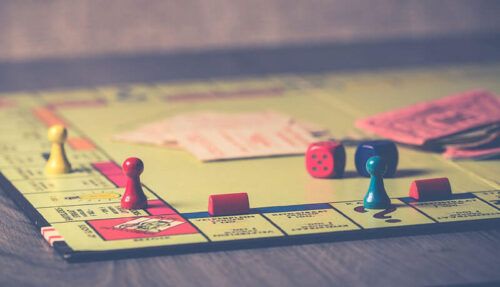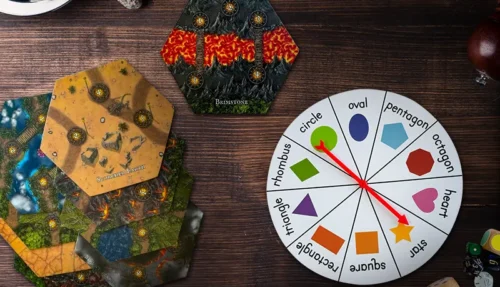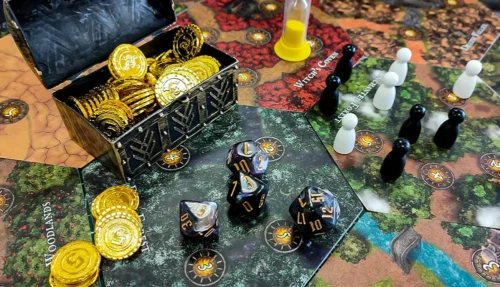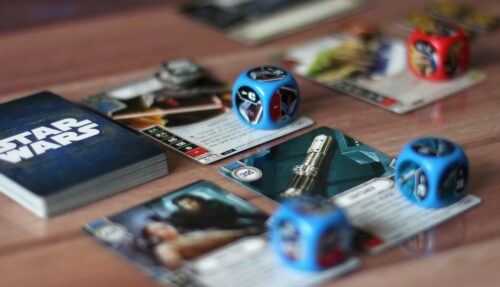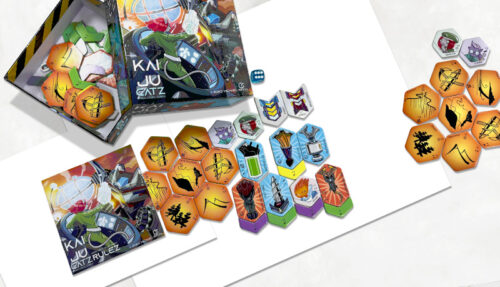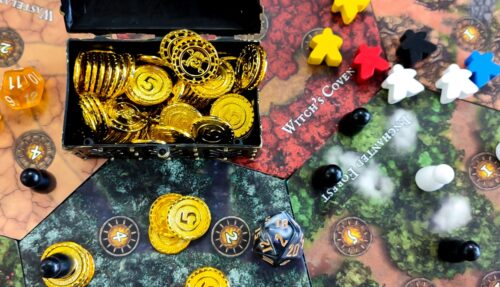Designing and developing a board game for a crowdfunding campaign is as much of a challenge as it is fun and rewarding. But it's important to understand what you're getting involved in before you fire up your campaign…
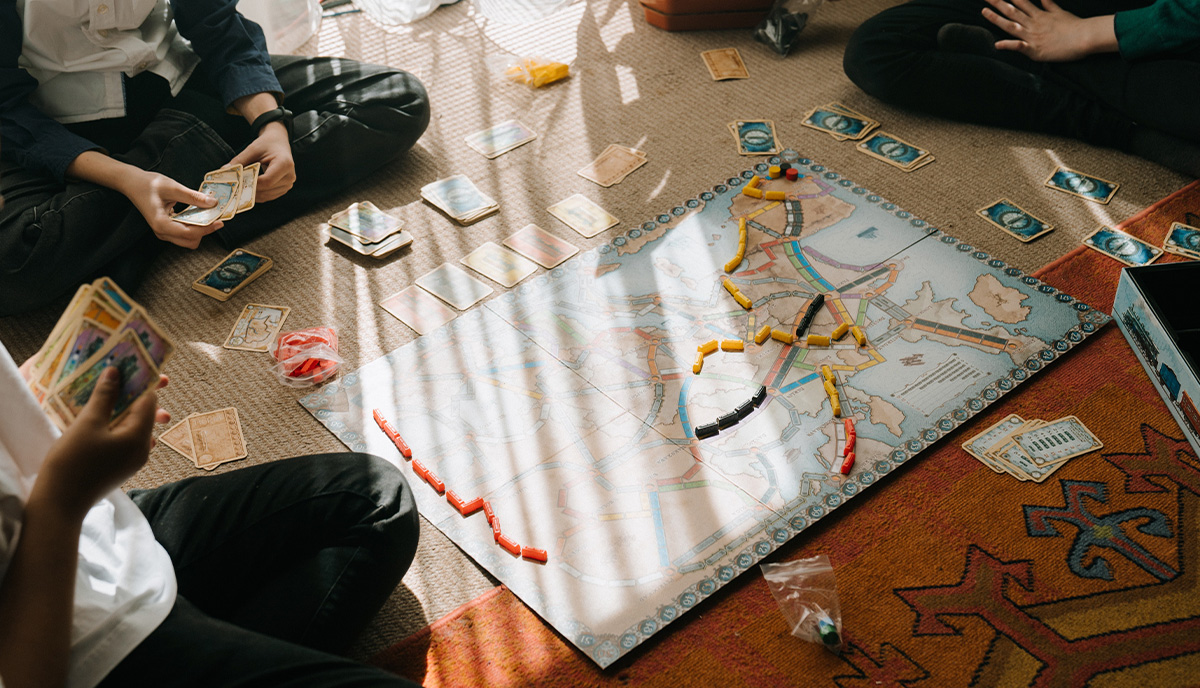
Photo by cottonbro via Pixabay.com
Going from getting a great idea for a game to designing, testing, manufacturing, promoting and selling it is an exciting journey. But as with any journey, it’s wise to study the map before you set out. That way you can plan the best route, prepare for any obstacles ahead, and give yourself the best chance of arriving at your destination as quickly and with as little trouble as possible. If you’re thinking about setting out on the journey of designing and developing a board game for a crowdfunding campaign, then this post — along with the other game development articles on this blog — are that map.
If it’s your first time taking this journey, you may find that parts of it pass through foreign territory and there’ll be new languages and customs to learn along the way. But that’s all part of the fun and excitement. And once you’re a seasoned traveler and you know the route well, each subsequent journey will be that much easier. Here’s a quick summary of the main landmarks and terrain you’ll come across on your board game development journey, more-or-less in the order you’ll meet them:
Leaving the journey/map analogy behind for now, let’s examine each of these “steps” in more detail. The reason why we’ve put “steps” in quote marks there — and the travel analogy breaks down — is because, while broadly speaking there’s an order to these activities, many of them run simultaneously or need prepping long before your put them into action. We warned you that board game development can be challenging, but we also assured you that it will be equally fun and rewarding. Let’s dive in.
Step one: ideas and design
Before you do anything else, you need to choose an idea and begin to design the game. You needn’t finish the game design before you start several of the next steps, but until you have a fairly clear and fixed idea of what the game will be about, the theme, and the fundamental mechanics, it will be hard to start building a social narrative around it or create a community of interest. Don’t worry if you’re not sure what those terms mean — we said you’ll need to learn a new language, and it will all become clear as we go on.
While this is “step one” in this list, game design is complex and iterative, so you’ll keep taking this step almost right through to the moment of production. Good game design involves every aspect of making a game from getting an idea, choosing a theme, experimenting with the mechanics, components, developing the “win condition” and writing the rules. And that means lots of early prototyping, play-testing, and adjustment. But first, as you may not be familiar with them all, let’s define the terms we’ve used so far.
- The idea is the core concept; the kind of game it is, if you like: think of a race game, a puzzle game, a combat game, a territorial game, and so on.
- The theme is the “story world” in which the game idea is embedded and expressed to engage the imagination of the players and create the game’s distinctive atmosphere.
- The mechanics are the ways in which actions can be taken in the context of the game.
- The components are the physical objects the game needs to work, such as the board itself, dice, cards, figures, and so on.
- The win condition is the state or objective that a player or players must achieve in order to win the game
- The rules are the set of instructions and constraints which decide what actions may be taken, when, by whom, and so on. They govern the operation of the mechanics and make the win condition both possible and difficult to achieve.
But designing and integrating all these aspects of a board game isn’t something which can be done in a single, linear process. As we said before, game design is an iterative process; each element needs testing and refining multiple times to arrive at a finished system which is well-balanced, functional, and gives the players a satisfying gaming experience. And this is where play-testing comes in.
Play-testing means exactly what it says: testing your game by playing it. But it’s not so straightforward as it may seem and you’ll always obtain the best results by adopting a fairly systematic and scientific approach. You can divide the play-testing process into three stages, like this:
- Self-testing — at this stage, your game is in the very early stages of design and it’s enough to play it by yourself, taking on, by turns, the role of each player. You won’t get detailed feedback at this level, but it’s a necessary first step toward getting a broad overview of the general strengths and weaknesses of your new board game. You’ll be using substitutions for all the components; so, the board may be sketched out roughly on a large sheet of paper, post-it notes may be stand-ins for cards, and found objects take the place of counters, miniatures, and so on.
- Companion testing — at this next stage, you’ve worked out a game that appears to function at least at the most basic level of its mechanics. Now, it’s time to get a few real people round the table to play out a session in real time. In most cases, you’ll ask your friends and family to play the game with you. During these sessions, you can explain the rules; ask for instant verbal feedback; make your own observations of players’ reactions and the smoothness, speed, and ease of play; and make adjustments “on the hoof”.
- Blind-testing — once you’ve play-tested the board game with several groups of friends and family members, rejigged, adjusted, adapted, and otherwise refined the rules according to their feedback and your own observations and reflections, then you can put the game before people who don’t know you and have no vested interest in your happiness! This is known as ‘blind testing’ and while it can be a bit scary, it’s a vital stage that must not be skipped. You can find blind testers by approaching a gaming club or asking at a game night you don’t normally attend; you can advertise for them either as volunteers or in exchange for a small reward (gift tokens, for example, are popular); and you can take your prototype along to conventions and meetups where there may be organized opportunities for game developers to have their games tested in this way.
Once your game has been thoroughly tested and “tweaked” until all functions well and players consistently give positive feedback about the play experience, you can move on to game production, which will start with a professional-level prototype and preparing the files for the printing and manufacture of the final game units to send to your crowdfunding supporters and sell on through your distribution channels.
Step two: board game prototyping and production
You’re now ready to make your game into a physical reality. This is where you transform your game from a homemade “rough” version into a beautiful printed board with professionally manufactured components and a slick rule book, all housed in a stunning custom-made box. In other words, it’s the stage at which your board game becomes a real proposition that can be bought, played, and enjoyed by others, indistinguishable in quality from other professional games on the market.
To achieve this, you’ll need to engage the services of an artist and a graphic designer to create the visual elements, branding, logo, and artwork and to format the layout of any text on cards, the board itself, in the rule book, and on the box. Unless you’re qualified and experienced to a professional level in art and graphic design, you shouldn’t attempt to do this yourself. Not least because there’re a lot of technical specifications relating to the choice of papers and card stocks, component manufacture, and preparing the digital files.
We recommend that you get your printer involved as early as possible in this part of the process. A good printer and game manufacturer — we smile and say hello, here! — will work closely with your designer and can provide all the technical and practical information and support needed, including manually checking each file before going to press to make sure that your prototype and final game product are faultless. In fact, we’d encourage you to make your first contact with us even before you get to this stage. Knowing what the practical and technical opportunities and limitations of printing and manufacturing are — and how much it will all cost — is good information to have before you begin to design your game.
Any printer worth their ink will always provide you with a test prototype of your finished board game, boxed and ready to play, for you to check and approve before going into full-scale manufacture. If you have any doubts, concerns, or questions at any point in all this, please talk to us. We’re here to help.
Step three: community building and crowdfunding
Designing, developing, testing, and printing/manufacturing your board game will cost time and money. You’ll need to make a careful, logical, realistic business plan, backed by a generous budget and protected by safeguards against the unexpected. The most popular, proven, and effective way to do this is through crowdfunding and the most secure way of making a crowdfunding campaign successful is by community building. Let’s look at this now, as it’s the most important aspect of your game development plan other than the game itself.
The independent board game industry — which is what you are becoming part of with your game design project — may be worth billions of dollars a year but it’s still a grassroots phenomenon and community with communication at its heart.
Before we look at the importance of building a community around your proposed board game, a word about Kickstarter. While other crowdfunding platforms exist and you may find success with them, Kickstarter has become the go-to platform both for game designers in search of funding and for game enthusiasts in search of new games to support. We haven’t space here to give you a detailed guide to the ins-and-outs of the platform itself but we’ll say that aside from giving you the best opportunity to connect with the right audience, its layout and functions are excellently adapted for board game campaigns.
You can’t really start too early when it comes building a community of interest and developing relationships which will convert curiosity into commitment. Your basic campaign starter should include at least one well-made video, no longer than three minutes, which explains the inspiration, creative concept, passionate purpose, ambition and scope of your proposal. Both your video and text content should be personal and focused on the positive experiences you can offer the supporter rather than on what you want to get out of the relationship. Think in terms of personal passion and delivering value. In many cases, the most successful campaigns don’t even mention money. Everyone knows why they’re there and supporters will commit spontaneously based on the relationship you build with them , the community that arises around your game idea, and how much they like you and your content.
And it’s quality, informative, and entertaining content that you need to deliver on Kickstarter — not marketing and sales pitches. Commit to regular updates on your progress in design, behind the scenes insights into how you’re working, exposes of your learning curve, and entertaining anecdotes alongside the practical facts and figures involved in your board game development. Video content used to be an “added extra” but it has really become an essential these days. While you should invest in professional video production if you have the capital, a crash course in quality D.I.Y. video production is a minimum requirement. But don’t get too hung up about it. It’s the content itself that really matters. A powerful story well-told — even if the video is a bit clunky — will top out a slick but dull production every time.
To help build a community, get out there and communicate both on the Kickstarter platform and on your social media, on YouTube, and in the real world at games nights, clubs, and conventions. And the secret, if there is one, is to be open, honest, enthusiastic, helpful, and sincere in your online and offline communications. Assuming that you have a good game in development, with time and perseverance, this is the best approach to guarantee that you build a community and that you convert enough of those people into supporters — the people who put their money behind you.
You’ll also need to invest time and effort into all the practical and legal sides of a crowdfunding campaign. That means everything from creating a timetable, maintaining your campaign updates, sending out a newsletter, offering rewards, arranging fulfilment and distribution, creating and managing goals and stretch goals, organizing your launch party, developing a safety-net back up plan and minimum deliverables should you miss your targets, paying your fees, taxes, and all the other “paperwork” that’s involved in running a successful crowdfunding campaign.
That may seem like a lot of work — and it is! But it can also be a huge amount of fun. Many of the people in your community may become real, lasting friends and several of your backers will be there to support your next project, too. It’s a steep learning curve, but take one step at a time, learn from your mistakes, keep at it with passion and determination, and you have every chance of success.
Step four: board game marketing and promotion
So, you’ve completed a great board game and enjoyed a successful launch. Now what? Once all your backers have received their games and other rewards, what happens next? You can’t expect your game to sell itself. You need to market and promote your board game.
Asking your backers to review your game based on their shared experience of playing the finished product is the first step. Get those reviews up on game sites, forums, social media groups, and in stores. You may have a website, a blog, and an e-commerce store of your own. Add content to that blog, link to it on your social media, let everyone know about your new board game. Stay in touch with your community and encourage them to help spread the word, keep up your newsletter, send out press releases and take your game to meetups and conventions.
You might also want to try for paid advertising if you have the capital. Paid ads on search engines and social media can work if you do your due diligence and learn how to use them effectively. You can also put ads in mainstream media outlets like newspapers, magazines, and radio and TV stations.
But the most powerful marketing and promotion will happen within the community by “word of mouth”. So, the best thing you can do to promote your new board game is to network, go to events, meet people, and get as many people to play your game as you can. If it’s a good game, eventually the word will spread, the sales will come in, and success will be yours.
Step five: board game distribution and sales
In order to sell your game beyond your Kickstarter campaign, you’ll need to set up a number of distribution channels through which people can buy it. Several options are open to you. Let’s list them here:
- Direct selling through your website and e-store
- Direct selling at events and conventions
- Selling through Amazon Fulfilment and other online outlets
- Selling through local games stores
To sell successfully through your own web store, you’ll need to drive traffic to it and that means writing and delivering great content consistently so that your site can be found in search engines like Google and Bing. It’s a lot of work, but if you’re a passionate gamer and love writing about all things to do with board games, it can be a fun way to build your business.
Attending conventions and other events is a must. Sign up as a trader, set up your stall, pay your fees and get to work. Conventions are also excellent networking opportunities.
You can have game units delivered to Amazon’s warehouses and set your game up in the store. People can then find and buy your game just as they find and buy anything on Amazon. Amazon store works much like a search engine, so you’ll need to do your homework and learn about setting up your sales page, choosing the right keywords, and more. And there are other stores, too, through which you can distribute your game. A quick Google search will turn up several options.
You can also get your game sold through as many independent games stores as you have the time and resources to visit. A quick phone call and a follow up visit, with a few sample copies of your game in tow, is the best approach. Many game stores also have tables for customers to hang out and play. Leaving a free promotional copy can be a worthwhile investment. If the store owner gets positive feedback on the game, they’ll more than likely be happy to stock a few units on a “sale or return” basis or even buy them outright from you at a wholesale price.
Price is an issue that can get quite complicated. But the basic principles are simple enough. You need the price tag on your game to cover all your outlay costs, including storage and distribution, and then add your profits on top. But at the same time, it needs to sit comfortably with current market expectations. So, check out the prices of as many games as you can find that are similar to yours and choose a competitive figure that still gives you a healthy return.
A journey of a thousand miles
There’s an old Chinese saying, “A journey of a thousand miles begins with the first step”. As you’ll understand now, going back to the analogy we started with, it’s a long trek across pretty varied territory to get from your first stirrings of an idea for a board game to selling hundreds or thousands of copies to the game-playing public. But with a good map and your own hard work and imagination, there’s no reason why you shouldn’t arrive at your destination and enjoy the journey, too. Just stake the first step.






